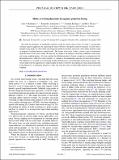Files in this item
Mode switching dynamics in organic polariton lasing
Item metadata
| dc.contributor.author | Moilanen, Antti J. | |
| dc.contributor.author | Arnardóttir, Kristín B. | |
| dc.contributor.author | Keeling, Jonathan | |
| dc.contributor.author | Törmä, Päivi | |
| dc.date.accessioned | 2022-11-07T12:30:02Z | |
| dc.date.available | 2022-11-07T12:30:02Z | |
| dc.date.issued | 2022-11-15 | |
| dc.identifier | 281862675 | |
| dc.identifier | b52d0bc1-c132-4fd2-87bb-6d2c29ae790e | |
| dc.identifier | 85141912435 | |
| dc.identifier | 000884992400006 | |
| dc.identifier.citation | Moilanen , A J , Arnardóttir , K B , Keeling , J & Törmä , P 2022 , ' Mode switching dynamics in organic polariton lasing ' , Physical Review B , vol. 106 , no. 19 , 195403 . https://doi.org/10.1103/PhysRevB.106.195403 | en |
| dc.identifier.issn | 2469-9950 | |
| dc.identifier.other | ArXiv: http://arxiv.org/abs/2206.07168v2 | |
| dc.identifier.other | ORCID: /0000-0002-4283-552X/work/122720264 | |
| dc.identifier.other | ORCID: /0000-0002-6624-2307/work/122720273 | |
| dc.identifier.uri | https://hdl.handle.net/10023/26312 | |
| dc.description | Funding: AJM and PT acknowledge support by the Academy of Finland under project numbers 303351, 307419, 327293, 318987 (QuantERA project RouTe), 318937 (PROFI), and 320167 (Flagship Programme, Photonics Research and Innovation (PREIN)), and by Centre for Quantum Engineering (CQE) at Aalto University. AJM acknowledges financial support by the Jenny and Antti Wihuri Foundation and ETH Zurich Postdoctoral Fellowship. KBA and JK acknowledge financial support from EPSRC program “Hybrid Polaritonics” (EP/M025330/1). KBA acknowledges support from The RSE Saltire Research Award. | en |
| dc.description.abstract | We study the dynamics of multimode polariton lasing in organic microcavities by using a second-order cumulant equation approach. By inspecting the time evolution of the photon mode occupations, we show that if multiple lasing peaks are observed in time-integrated mode occupations, the reason can be either bi-modal lasing or temporal switching between several modes. The former takes place within a narrow range of parameters while the latter occurs more widely. We find that the origin of the temporal switching is different in the weak- and strong-coupling regimes. At weak coupling slope efficiency is the determining factor, while for strong coupling it is changes in the eigenmodes and gain spectrum upon pumping. This difference is revealed by investigating the photoluminescence and momentum-resolved gain spectra. Our results underscore the importance of understanding the time evolution of the populations when characterizing the lasing behaviour of a multimode polariton system, and show how these features differ between weak and strong coupling. | |
| dc.format.extent | 13 | |
| dc.format.extent | 7258829 | |
| dc.language.iso | eng | |
| dc.relation.ispartof | Physical Review B | en |
| dc.subject | QC Physics | en |
| dc.subject | TK Electrical engineering. Electronics Nuclear engineering | en |
| dc.subject | DAS | en |
| dc.subject | MCC | en |
| dc.subject.lcc | QC | en |
| dc.subject.lcc | TK | en |
| dc.title | Mode switching dynamics in organic polariton lasing | en |
| dc.type | Journal article | en |
| dc.contributor.sponsor | EPSRC | en |
| dc.contributor.sponsor | The Royal Society of Edinburgh | en |
| dc.contributor.institution | University of St Andrews. School of Physics and Astronomy | en |
| dc.contributor.institution | University of St Andrews. Centre for Designer Quantum Materials | en |
| dc.contributor.institution | University of St Andrews. Condensed Matter Physics | en |
| dc.identifier.doi | https://doi.org/10.1103/PhysRevB.106.195403 | |
| dc.description.status | Peer reviewed | en |
| dc.identifier.grantnumber | EP/M025330/1 | en |
| dc.identifier.grantnumber | 1949 | en |
This item appears in the following Collection(s)
Items in the St Andrews Research Repository are protected by copyright, with all rights reserved, unless otherwise indicated.

